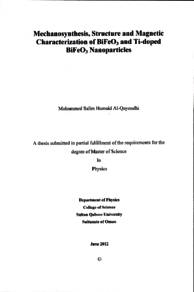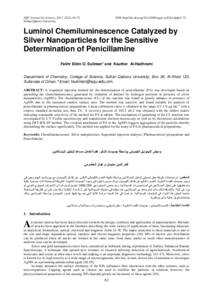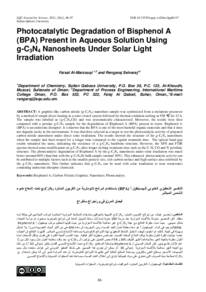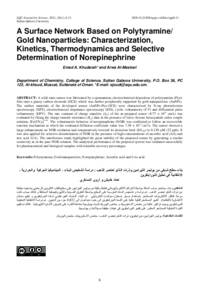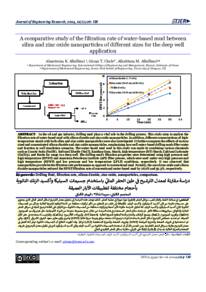وثيقة
Mechanosynthesis, structure and magnetic characterization of BiFeO3 and Ti-doped BiFeO3 nanoparticles
الناشر
Sultan Qaboos University
ميلادي
2012
اللغة
الأنجليزية
الملخص الإنجليزي
In this thesis we report on our attempts to mechanosynthesize single-phased nanocrystalline pure and Ti-doped BiFeO; (bismuth ferrite) in a bid to solve the documented problem that it is difficult to synthesize single phases of these materials via thermally-assisted routes. We also report on the structural and magnetic properties of the best single-phased nanocrystalline particles of both materials that we managed to synthesize. Mechanosynthesis was attempted with a planetary ball mill machine by subjecting an initial 1: I molar mixture of a-Bi,O, and c-Fe,0, (or Ti" -doped a-Fe,Os) to two distinct milling regimes. In the first, Milling Regime (1), a milling speed of 300 rpm and a ball-to-mass ratio of 15: I were used, whereas in the second, Milling Regime (2), the values of 600 rpm and 22: 1 were used, respectively. To our knowledge, our study is the first where Tie-doped and a-Fe, was used as a precursor to produce Ti-doped BiFeO, rather than using stoichiometric amounts of a-Fe,0, and TiO, (separately). With Milling Regime (1), an almost single(-97%) rhombohedral BiFeO; nanocrystalline phase can form after 100 h of milling followed by heating at 780 °C (7.5 min). The average crystallite size is found to be 82 nm and particle size ranges between 50 nm and 150 nm. Almost singlephased (98%) cubic Ti-doped BiFeO3 nanocrystalline particles form using the Milling Regime (1) for 60 h followed by heating at 850 °C (7.5 min). The average crystallite size 41 nm and average grain size of -50-300 nm. With Milling Regime (1), while our results are generally better than many published ones, it was not possible to get rid of the very small amounts (< 2%) impurity sillenite (Bisfe04/BiasFeOs), mullite (BizFe 0,) and 6-Bi20, phases that develop with heating. Milling Regime (2) has facilitated the formation of BiFeO, without passing through the intermediate phases. With this regime, single-phased ( 98%) nanocrystalline cubic BiFeO, particles were formed by heating reactants at 400 °C for lh after milling for 48 h. The crystallite size was-19 nm and the particle size varies in range-5-40 nm. Cubic Ti-doped BiFeO, single-phased ( 98% ) nanocrystalline particles, with average crystallite and particle size of less than 10 nm, were found to form by milling the reactants using Milling Regime (2) for 32 h at room temperature. The Mössbauer spectra of the nanocrystalline BiFeO, particles prepared with Milling Regime (2) show the presence of a -12% superparamagnetic component with blocking temperatures less than 78 K. The almost zero quadrupole splittings in the spectral component of the larger "magnetic" nanocrystalline BiFeO; particles indicate the cubic nature of their structure in agreement with the XRD data. That no Mössbauer signal was detected from the Ti-doped BifcO; nanoparticles could be related to their very small particle (crystallite) sizes (<10 nm) that lead to collective magnetic excitations resulting in broadening and a poor resolution of the Mössbauer lines. The magnetization of the BiFeO, nanoparticles prepared using Milling Regime (2) is -3 times and their magnetic hardness is -14 times larger than those of the corresponding bulk. The Ti-doped BiFeO; nanocrystalline particles show a complex weak ferromagnetic behaviour. These results are mainly attributed to the reduction of particle size below a critical characteristic length and the weakening of the magnetic exchange interaction due to the presence of the nonmagnetic TT ion in the magnetic lattice.
المجموعة
URL المصدر
الملخص العربي
في هذه الأطروحة تناقش نتائج محاولاتنا لتحضير الجسيمات النانومترية أحذية الطور للمركب ;Bife0 و وBile0 المشوب بابون التيتانيوم الرباعي **Ti ، بهدف حل المشكلة الموثقة المتعلقة بصعوبة تحضير الطور الأحادي لهذين المركبين من خلال طرق التحضير المعتمدة على استخدام الحرارة. كذلك نقوم بدراسة الخصائص التركيبية و المغناطيسية لأنقى جسيمات نانومترية أحادية الصور للمادتين اللتين قمنا بتحضيرها. تم التحضير بالطحن بواسطة الة الطحن بالكرات حيث تم طحن الخليط الأساسي المعد بالنسبة المولية 1: 1 من مركي , a - BigO و -4 وFe20 عبر نظامين مختلفين. نظام الطحن (1) ، استخدمت سرعة طحن 300 دورة في الدقيقة ونسبة كتلة الكرات الى الخليط حوالي 1 : 15 ، بينما كانت القيمتان في نظام الطحن (2) ، 6000 دورة في الدقيقة و 1 : 22 على التوالي إلى مدى علمنا، دراستنا هي الأولى من نوعها من حيث استخدام ;0:Fe-1 المشوب ب **Ti في الخليط الأساسي الانتاج ;Bife0 المشوب به **Ti بدلا من استخدام كميات مكافئة من مركبي ;0:Fe-0 و TiO2 بشكل منفصل وجد أنه باستخدام نظام الطحن (1) إنه يمكن تكوين المركب ;BiFe0 على هيئة جسيمات نانومترية ذات ترکیب بلوري معيني الأوجه في معظمها أحادية الطور (%97) تكوت بعد h 100 من الطحن متنوعة بالتسخين عند ) 780 (min 7 . 5)، وجد أن متوسط الحجم البلوري nrn
82 وحجم الجسيمات يتراوح بين 50 إلى 150 fifri كذلك الحال وجد أنه باستخدام نظام الطحن (1) فإنه يمكن تكوين المركب ;Bile0 المشوب به T على هيئة جسيمات نانومترية ذات تركيب بلواري مكعب في معظمها أحادية الطور (%98 ) تكونت بعد h 60 من الطحن متبوعة بالتسخين عند درجة min) 850 °C7 .5). وجد أن متوسط الحجم البلوري 41nm وحجم الجسيمات بتراوح بين tiin 50 إلى nm 300، عند استخدام نظام الطحن (1) ورغم أن نتائجنا المعروضة هنا افضل من حي الشفاء من كثير من تلك التي نشرت سابقا، فإننا لم نتمكن من التخلص من الكميات الصغيرة من مرکبات، السيلفایت (وهBigFO ور BigFC) ، المولات وBig Fe0 و ;Big0-ة والمتكونة خلال التسخين. نظام الملحن (2) سهل تكوين و0"13if بدون الحصول على مركبات وسطية حيث وجد أنه باستخدام نظام الطحن (2) ممكن تكوين المركب ;()Bile على هيئة جسيمات نانومترية ذات تركيب پلوري مكعب في معظمها أحادية الطور (989 ) تكونت بعد
82 وحجم الجسيمات يتراوح بين 50 إلى 150 fifri كذلك الحال وجد أنه باستخدام نظام الطحن (1) فإنه يمكن تكوين المركب ;Bile0 المشوب به T على هيئة جسيمات نانومترية ذات تركيب بلواري مكعب في معظمها أحادية الطور (%98 ) تكونت بعد h 60 من الطحن متبوعة بالتسخين عند درجة min) 850 °C7 .5). وجد أن متوسط الحجم البلوري 41nm وحجم الجسيمات بتراوح بين tiin 50 إلى nm 300، عند استخدام نظام الطحن (1) ورغم أن نتائجنا المعروضة هنا افضل من حي الشفاء من كثير من تلك التي نشرت سابقا، فإننا لم نتمكن من التخلص من الكميات الصغيرة من مرکبات، السيلفایت (وهBigFO ور BigFC) ، المولات وBig Fe0 و ;Big0-ة والمتكونة خلال التسخين. نظام الملحن (2) سهل تكوين و0"13if بدون الحصول على مركبات وسطية حيث وجد أنه باستخدام نظام الطحن (2) ممكن تكوين المركب ;()Bile على هيئة جسيمات نانومترية ذات تركيب پلوري مكعب في معظمها أحادية الطور (989 ) تكونت بعد
قالب العنصر
الرسائل والأطروحات الجامعية

